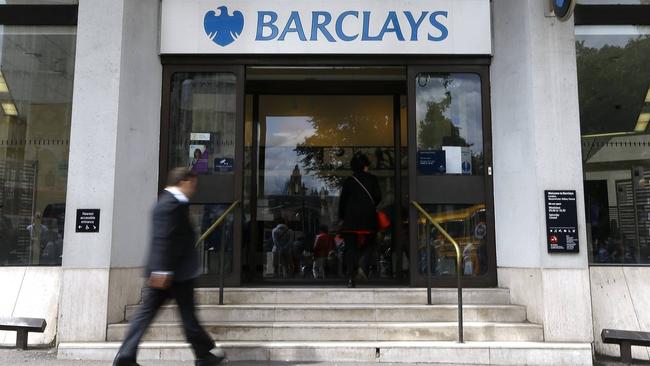Barclays to exit Australian market in global restructure
Barclays has pulled the pin on Australia as part of a broad restructure that could see more than 1000 jobs lost.

Barclays has pulled the pin on Australia as part of a broad restructure, becoming the latest casualty since the global financial crisis to succumb to the bruising cocktail of slower markets, stricter regulation and hot competition.
Ending roots in Australia established in 1969, Barclays yesterday notified staff of the measures that could result in more than 1000 job cuts globally as new chief Jes Staley refocuses efforts back to core markets in Britain, Europe and the US.
It includes closing cash equity research, sales and trading, and convertible bond trading businesses in Asia, plus the exit from Taiwan and South Korea, according to Dow Jones Newswires.
In Australia, about 70-80 staff would be affected across its operations — which are more modest than some foreign banks — spanning debt capital markets, lending, mergers and acquisitions advisory, foreign exchange and risk management, sources said.
Mr Staley was installed in October by chairman John Macfarlane, the former chief of ANZ who last year reportedly said Barclays did not want to be a “100-country investment bank” and Asia was “not performing and we don’t like things that actually don’t make money”.
One former Barclays banker, who declined to be named, said the withdrawal from Australia had been in the works for some time and the Asia business had “not made any money for a long time”.
While Barclays’ decision is not surprising — The Australian reported the local operations were under review almost a year ago — it continues the exit of foreign banks amid a global trend to simplify and shrink, in stark contrast to pre-GFC when banks expanded business lines and geographies.
Last year, Malaysia’s CIMB spectacularly shuttered its mostly loss-making Australian operations in favour of servicing the country from Asian hubs, just three years after entering via the acquisition of Royal Bank of Scotland’s local investment bank.
Lloyds has withdrawn, while RBS is offloading its Australian corporate and institutional banking operations.
Investec and Nomura have also wound back their presence, including the latter shutting its equities arm, while Commonwealth Bank recently shut its institutional stockbroking business.
Barclays’ exit comes after the British bank’s hyped plans to build out its Australian investment banking operations post the GFC, when the group expanded globally via the acquisition of Lehman Brothers’ US operations.
While achieving some successes in advising companies on M&A and debt deals, Barclays never built an equities arm that would have provided the full suite of offerings offered by rival global “bulge bracket” investment banks such as UBS or Goldman Sachs.
In recent years, the bank also suffered the progressive loss of several senior bankers, including Cynthia Whelan, Dan Janes, Tim Lindley, Steven Boggiano and Anthony Lazzoppina.
However, Barclays is not alone in shrinking its global network and product offerings, with Deutsche Bank, HSBC and Standard Chartered recently also planning thousands of job cuts and geographic overhauls as litigation costs and tougher regulation forces painful overhauls.
Another former local banker said Barclays erred in its investment banking build-out in Australia post-crisis by not initially hiring more “grey-haired” bankers.
“When you’re competing with the likes of UBS, Goldman and Macquarie, who have so many people with access into boardrooms etc, you can’t just hire lots of capable young guys and expect to compete,” said the former banker, also requesting anonymity.
The appointment of Jeff Deck as country head in 2013 from Asia was also questioned, with former staff questioning his level of Australian contacts.



To join the conversation, please log in. Don't have an account? Register
Join the conversation, you are commenting as Logout